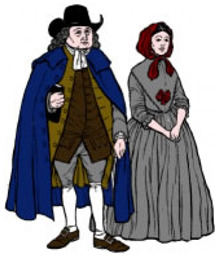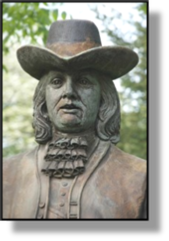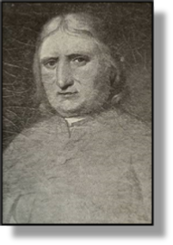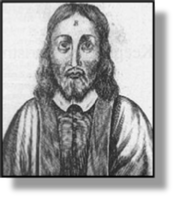


THE QUAKERS (THE SOCIETY OF FRIENDS) 1650 (CW)
Acknowledgements
Penn: detail from a statue in New Castle, Delaware, the work of the American sculptor Charles Parks (1922-
Including:
George
Fox

xxxxxThe Society of Friends, a Puritan movement, was founded by the travelling preacher George Fox in the late 1640s. In 1650 its members acquired the name “The Quakers” after Fox instructed that they should “quake at the word of the Lord”. The movement held that every person possessed an “inner light” by which to perceive the word of God, so there was no need for trained clergy or an authoritarian church. Conduct was based on toleration, care for the needy, and a belief in the essential goodness of human nature. The movement spread rapidly on the continent and in the American colonies, and Quakers became pioneers in social reform, like Elizabeth Fry and the industrialist George Cadbury.
 xxxxxThe Society of Friends, a Puritan movement sometimes known as the Children of Light, was founded by the English travelling preacher and missionary George Fox in the late 1640s. Its members acquired their popular name "The Quakers" in 1650 when, so we are told, Fox instructed his followers to "quake at the word of the Lord". Apart from its considerable religious impact, the movement also went on to produce a number of outstanding social pioneers, including the prison reformer Elizabeth Fry, and the enlightened industrialist George Cadbury.
xxxxxThe Society of Friends, a Puritan movement sometimes known as the Children of Light, was founded by the English travelling preacher and missionary George Fox in the late 1640s. Its members acquired their popular name "The Quakers" in 1650 when, so we are told, Fox instructed his followers to "quake at the word of the Lord". Apart from its considerable religious impact, the movement also went on to produce a number of outstanding social pioneers, including the prison reformer Elizabeth Fry, and the enlightened industrialist George Cadbury.
xxxxxThe fundamental belief of its members is that every person possesses an "inner light" by which they may perceive the word of God. Living strictly according to the word of Christ, they emphasise truth and sincerity and follow a simple life-

xxxxxDespite being ridiculed for their sombre attitude to life, and persecuted for their unorthodox Christian views, membership rapidly increased, and the movement spread to the continent and North America in the 1660s. Here, as in England, the Friends became pioneers in social reform. In the American colonies the largest areas of settlement were in Rhode Island, North Carolina, western New Jersey and the colony of Pennsylvania, founded by the Quaker William Penn (illustrated) in 1682 (C2). In the 19th century divisions emerged within the movement -
xxxxxThexdoctrine of the "inner or inward light" was ably expounded in 1678 by the Scottish Quaker Robert Barclay (1648-
 xxxxxThe movement's founder, George Fox (1624-
xxxxxThe movement's founder, George Fox (1624-
xxxxxA man of enormous self-
xxxxxFrom 1666 he devoted most of his time to expanding the work of the movement. He visited the West Indies and North America in 1671 in order to extend the Quaker communities, and later travelled to parts of northern Europe. He spent the last fifteen years of his life in and around London. He wrote a number of controversial pamphlets on social as well as religious matters, and in 1675 began writing a detailed diary of his life. This formed the basis of his Journal, edited and published in 1694 under the supervision of his friend and admirer William Penn.
 xxxxxIncidentally, a prominent Quaker at this time was James Naylor (1616-
xxxxxIncidentally, a prominent Quaker at this time was James Naylor (1616-
xxxxx…… Part of his punishment included the branding of his forehead with the letter “B” for blasphemer, as shown in the illustration.
xxxxxAfter experiencing a series of spiritual revelations, the founder of the Quakers, George Fox (1624-
CW-


